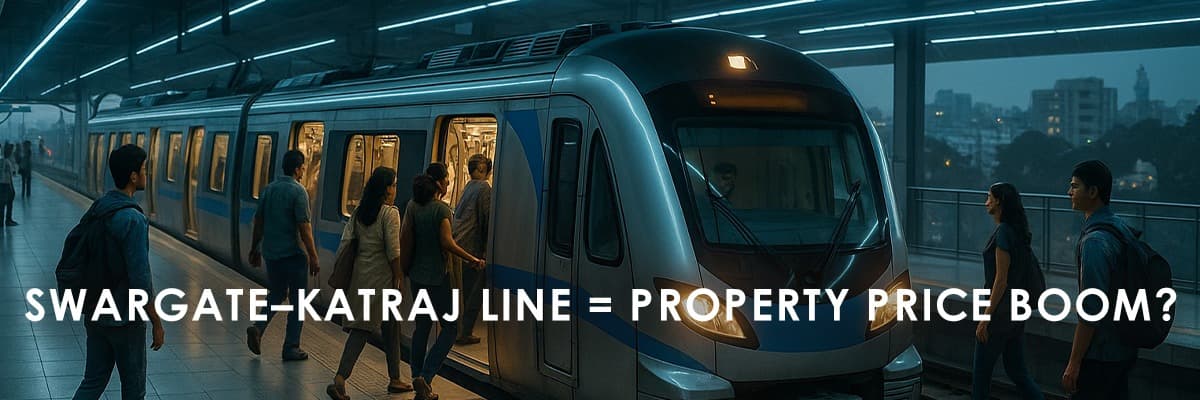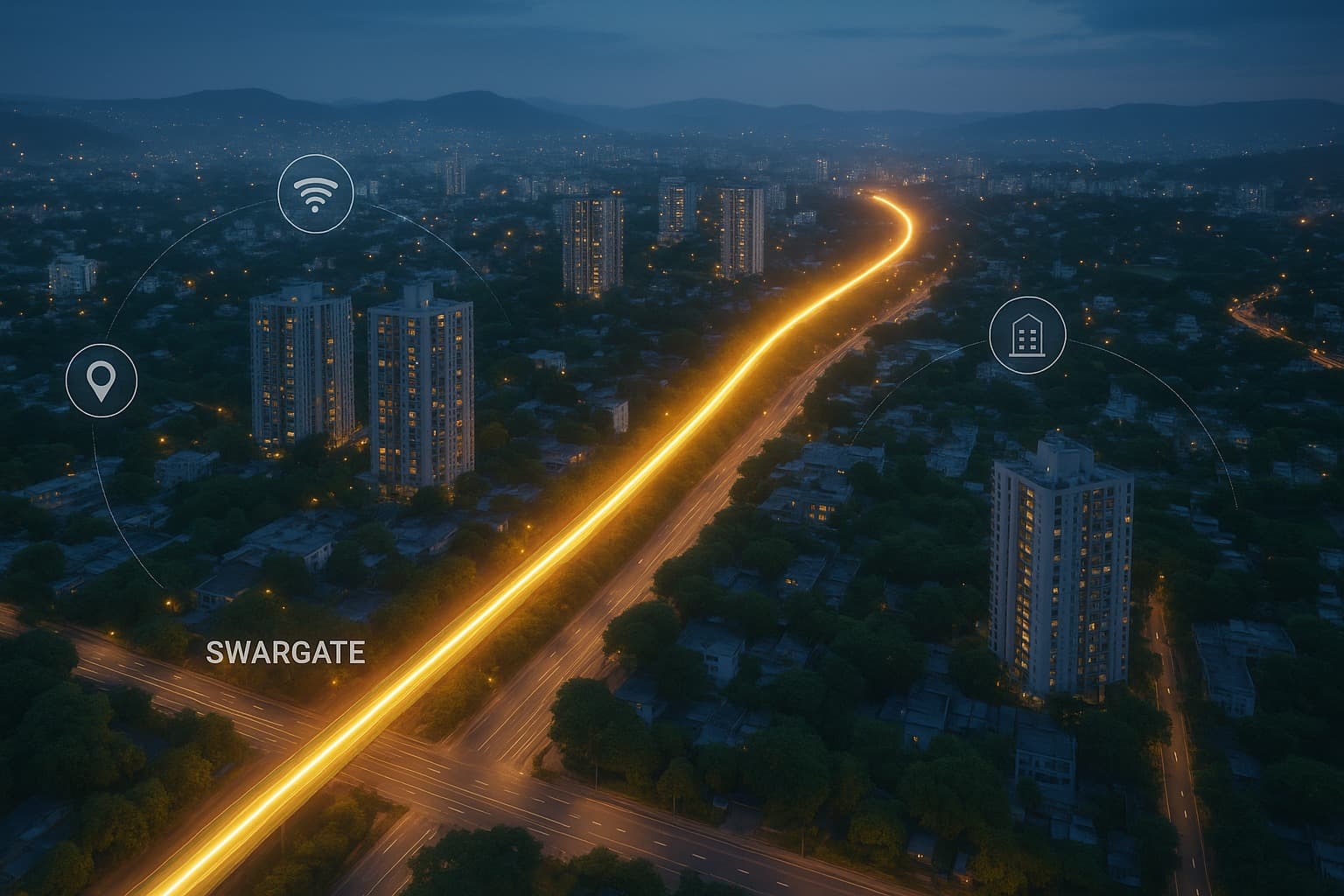Swargate–Katraj Underground Metro 2025: Boost for Pune Property Prices & Connectivity
Summary
The Swargate-Katraj underground metro in Pune (2025) promises reduced commute times, boosted property values, and enhanced connectivity. It will transform life for residents, students, and businesses along the corridor, making Pune more livable.

Pune, a city that hums with life from dawn till late night, is about to witness a transformation that will touch every street, every home, and every heartbeat. The approval of the Swargate–Katraj underground metro, part of Pune Metro Phase 2, isn’t just an infrastructure development—it’s a life-changing project that promises to redefine commuting, real estate, and the very rhythm of Pune life.
For years, residents of Katraj, Swargate, and neighborhoods in between have faced long, exhausting commutes, battling traffic jams, crowded buses, and the never-ending honking of city streets. Students, working professionals, and families alike have often sacrificed time, energy, and peace just to reach their workplaces or schools. But with this underground metro, the city’s pulse is set to change.
The Corridor: A Lifeline for Southern Pune
The Swargate–Katraj underground metro connects two critical parts of Pune:
Swargate: Pune’s bustling transport hub, where buses, local trains, and private vehicles converge. While a center of activity, Swargate has long struggled with congestion. The metro station here will become a modern, efficient hub, reducing pressure on roads and easing travel.
Katraj: Once considered slightly disconnected, Katraj is a mix of residential calm, schools, and small businesses. With the metro, it transforms into a prime residential and commercial corridor, bridging serenity with accessibility.
This 12–15 km underground stretch will cut travel time dramatically, offering Puneans a faster, safer, and stress-free commuting option.
Human Stories: Life Along the Metro
Let’s step into the lives of the people who will feel the impact personally.
Meera – The Software Professional
Meera, a 28-year-old software engineer, lives in Katraj and works near Swargate. Currently, her daily commute takes nearly 2.5 hours, draining her energy and leaving her little time for hobbies or family.
With the underground metro:
She can board the train at 8 a.m. and reach her office in just 25–30 minutes.
She now has evenings free for yoga, reading, or spending quality time with her parents.
Weekend trips to nearby scenic spots become feasible, reclaiming the leisure time she lost in traffic.
For Meera, the metro isn’t just convenience—it’s freedom, balance, and a healthier lifestyle.
Rahul & Priya – Young Family Dreams

Rahul and Priya live near Katraj with their 3-year-old daughter. They dream of moving closer to Swargate to be near their offices but always hesitated because of traffic and commute stress.
With the metro, they can consider investing in a home along the corridor, knowing that daily travel will be fast and predictable.
Weekends transform from stressful city drives to relaxing family outings in central Pune or nearby cafes.
The metro is hope turned tangible—a project that lets young families plan their lives with confidence and ease.
Aarav – The College Student
Aarav studies in Swargate but lives in Katraj. Today, he spends 90 minutes on buses and shared rides to reach college. After 2025:
His commute will shrink to 20 minutes, giving him extra time to study, pursue hobbies, and participate in sports.
Stress and fatigue reduce, making his student life more enjoyable and productive.
For students like Aarav, the metro is an investment in their personal growth, not just convenience.
Priya – The Small Entrepreneur
Priya runs a boutique café in Katraj. Currently, her business depends on local foot traffic, which is limited.
With the metro operational, commuters passing through Katraj and Swargate stations increase her customer base exponentially.
This not only boosts revenue but also allows her to expand her café or start a small chain, growing alongside the city’s development.
The metro becomes a lifeline for local businesses, fostering economic growth and opportunity.
Real Estate Transformation
Metro lines aren’t just transport solutions—they reshape urban living and property markets. The Swargate–Katraj underground line will have a profound effect:
Swargate: Residential and commercial properties near the metro hub will see premium appreciation, as connectivity makes it easier to live, work, and socialize in central Pune.
Katraj: Once a quieter suburb, Katraj becomes a prime residential destination. Peaceful neighborhoods now connect seamlessly with the city core.
Intermediate areas: Localities between Swargate and Katraj will witness a real estate surge, with apartments, townships, and retail spaces catering to metro commuters.
Investors and homebuyers are already eyeing strategic locations along the corridor, anticipating high appreciation and long-term benefits.
Emotional & Lifestyle Benefits
While property values matter, the human impact is immeasurable:
Parents save hours previously lost in traffic, spending quality time with children.
Professionals arrive at work energized, improving productivity and mental health.
Students can focus on studies, hobbies, and social life without enduring commuting exhaustion.
The metro restores time, energy, and emotional balance, fundamentally improving Puneans’ lives.
Investor Insights
For property investors, the Swargate–Katraj line is golden real estate territory:
Early investment advantage: Properties near metro stations will likely appreciate quickly.
Mixed-use development potential: Combining residential, retail, and office spaces ensures faster ROI.
Suburban hubs turning premium: Katraj, Swargate-adjacent areas, and intermediate neighborhoods are future hotspots.

The metro isn’t just a transport project—it’s a growth corridor for life and investment alike.
Challenges & Considerations
Like any mega project, there are temporary challenges:
Construction-related disruptions during station and tunnel development.
Residents must adapt to new commuting and urban patterns.
Environmental and heritage considerations require sensitive planning.
Yet, the long-term gains—shorter commutes, lifestyle improvements, property appreciation—far outweigh these temporary hurdles.
A Day in the Future – 2025
Picture a day in the transformed Pune:
Katraj: Meera boards the metro, greeted by fellow commuters, sipping chai, reading, or catching up on news.
Swargate: Aarav and his college friends step off the metro, stress-free and ready for classes or internships.
Local businesses: Shops and cafés near stations see increased footfall, boosting local economies.
The metro isn’t just infrastructure—it’s the pulse of a city connecting people, dreams, and opportunity.
Pune Metro 2025 – More Than Transport
The Swargate–Katraj underground metro represents connection, growth, and human-centered urban development:
Linking southern suburbs with central Pune, reducing congestion.
Boosting real estate demand, turning quiet neighborhoods into thriving communities.
Improving quality of life, reclaiming hours previously lost to traffic and stress.
For Puneans, Metro Phase 2 isn’t just a project—it’s a gateway to smarter, more livable, and opportunity-rich city life.
Final Thoughts
The Swargate–Katraj underground metro is more than tunnels and stations. It’s about changing lives, reclaiming time, and unlocking potential. From students and young professionals to families and entrepreneurs, everyone stands to gain. Real estate, lifestyle, and economic growth along the corridor will flourish. Infrastructure here isn’t just functionality—it’s hope, opportunity, and improved quality of life, making Pune a connected, vibrant, and human-centered city.
⭐ 100-Word Human Summary
The Swargate–Katraj underground metro, part of Pune Metro Phase 2, will transform commuting, lifestyle, and real estate in Pune by 2025. Residents will save hours, gain time for family, studies, and personal activities, and enjoy less stress. Property demand is set to rise in Katraj, Swargate, and neighborhoods along the corridor, turning suburbs into thriving residential and commercial hubs. Entrepreneurs will benefit from increased footfall, while young professionals and students enjoy smoother commutes. Beyond economics, the metro is profoundly human—connecting communities, creating opportunities, reclaiming time, and shaping Pune into a smarter, more livable, and vibrant city.
